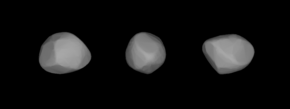 A three-dimensional model of 129 Antigone based on its light curve. | |
| Discovery | |
|---|---|
| Discovered by | Christian Heinrich Friedrich Peters |
| Discovery date | 5 February 1873 |
| Designations | |
| (129) Antigone | |
| Pronunciation | /ænˈtɪɡəniː/[1] |
Named after | Antigone |
| A873 CA; 1878 CA; 1907 BA | |
| Main belt | |
| Orbital characteristics[2] | |
| Epoch 31 July 2016 (JD 2457600.5) | |
| Uncertainty parameter 0 | |
| Observation arc | 112.47 yr (41080 d) |
| Aphelion | 3.4773 AU (520.20 Gm) |
| Perihelion | 2.26344 AU (338.606 Gm) |
| 2.87038 AU (429.403 Gm) | |
| Eccentricity | 0.21145 |
| 4.86 yr (1776.3 d) | |
Average orbital speed | 17.39 km/s |
| 97.3536° | |
| 0° 12m 9.619s / day | |
| Inclination | 12.262° |
| 135.703° | |
| 111.076° | |
| Earth MOID | 1.2837 AU (192.04 Gm) |
| Jupiter MOID | 1.7487 AU (261.60 Gm) |
| TJupiter | 3.232 |
| Physical characteristics | |
| Dimensions | 113[2] 119.44 ± 3.91 km[3] |
| Mass | (2.65 ± 0.89) × 1018 kg[3] |
Mean density | 2.96 ± 1.04 g/cm3[3] |
Equatorial surface gravity | 0.0349 m/s2 |
Equatorial escape velocity | 0.0661 km/s |
| 4.9572 h (0.20655 d)[2][4] | |
| 0.164 | |
| Temperature | ~164 K |
| M | |
| 9.71 (brightest?) | |
| 7.07 | |
Antigone (minor planet designation: 129 Antigone) is a large main-belt asteroid. Radar observations indicate that it is composed of almost pure nickel-iron. It and other similar asteroids probably originate from the core of a shattered Vesta-like planetesimal which had a differentiated interior. It was discovered by German-American astronomer C. H. F. Peters on February 5, 1873, and named after Antigone, the Theban princess in Greek mythology.
In 1979 a possible satellite of Antigone was suggested based on lightcurve data.[5] A model constructed from these shows Antigone itself to be quite regularly shaped. In 1990, the asteroid was observed from the Collurania-Teramo Observatory, allowing a composite light curve to be produced that showed a rotation period of 4.9572 ± 0.0001 hours and a brightness variation of 0.34 ± 0.01 in magnitude. The ratio of the lengths of the major to minor axes for this asteroid were found to be 1.45 ±0.02.[4]
10μ radiometric data collected from Kitt Peak in 1975 gave a diameter estimate of 114 km.[6] Since 1985, a total of three stellar occultations by Antigone have been observed. A favorable occultation of a star on April 11, 1985, was observed from sites near Pueblo, Colorado, allowing a diameter estimate of 113.0 ± 4.2 km to be calculated.[7]
YouTube Encyclopedic
-
1/1Views:723
-
Rhodope occults Regulus
Transcription
References
- ^ Noah Webster (1884) A Practical Dictionary of the English Language
- ^ a b c Yeomans, Donald K., "129 Antigone", JPL Small-Body Database Browser, NASA Jet Propulsion Laboratory, retrieved 12 May 2016.
- ^ a b c Carry, B. (December 2012), "Density of asteroids", Planetary and Space Science, vol. 73, pp. 98–118, arXiv:1203.4336, Bibcode:2012P&SS...73...98C, doi:10.1016/j.pss.2012.03.009. See Table 1.
- ^ a b Dotto, E.; et al. (June 1992), "M-type asteroids - Rotational properties of 16 objects", Astronomy and Astrophysics Supplement Series, vol. 95, no. 2, pp. 195–211, Bibcode:1992A&AS...95..195D.
- ^ Johnston, Wm. Robert (17 February 2013), "Other Reports of Asteroid/TNO Companions", Johnston's Archive, retrieved 29 March 2013.
- ^ Morrison, D.; Chapman, C. R. (March 1976), "Radiometric diameters for an additional 22 asteroids", Astrophysical Journal, vol. 204, pp. 934–939, Bibcode:2008mgm..conf.2594S, doi:10.1142/9789812834300_0469.
- ^ Wasserman, L. H.; et al. (June 1986), "The Occultation of AG + 20° 1138 by 129 Antigone on 11 April 1985", Bulletin of the American Astronomical Society, vol. 18, p. 797, arXiv:1203.4336, Bibcode:2012P&SS...73...98C, doi:10.1016/j.pss.2012.03.009.
External links
- 129 Antigone at AstDyS-2, Asteroids—Dynamic Site
- 129 Antigone at the JPL Small-Body Database
